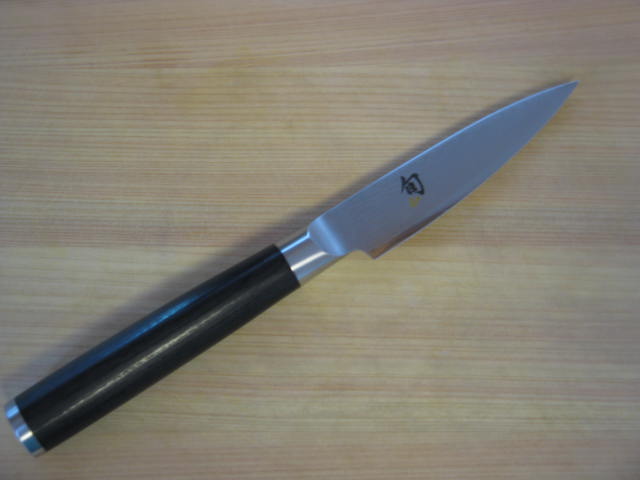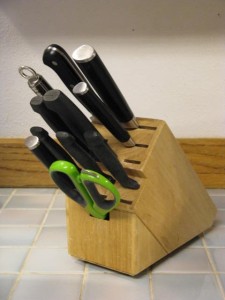Buy what you will use! Look at everything that comes in a set, and think about what you actually use most of the time. This is tricky if you’re a new cook, but hold the knives and think about what you would grab for the items you plan to prepare the most. I recommend buying knives one at a time to save on upfront costs, and also to get what you really need. Tell the salesperson what you are going to cut and hopefully they are smart enough to give you proper recommendations, let you hold and at least pretend to cut with the knife you are potentially purchasing.
A lot of sets come with knives you’ll never use. My absolute favorite gimmick in a lot of less expensive sets is including a Santoku and a Chef knife (usually around 7” & 8”, respectively). These are essentially the same knife. Some people prefer the shape of a Santoku, some prefer the shape of a Chef. This is all. But some people like having both since it’s a good size to use, so in that case, the set is worth something to you.
Santokus are actually also considered the “dollar store” knife of Japan, but were marketed to Americans as the Japanese chef knife. They use very specific knives depending on what they are cutting, which are generally related to cutting fish. Since Americans want them, even the Asian knife manufacturers make them.
Another thing you will see on Santoku knives, as well as other knives sometimes, are these little divots along the blade. This is called hollow ground, and it’s supposed to help keep things from sticking to the knife. The folding on an Asian knife makes the knife naturally nonstick, but again, because people demand it, you will see this on some Asian knives anyway.
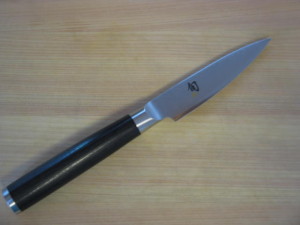 |
| 4″ Paring Knife |
Generally, these are the three most essential knives:
1. 8” Chef/7” Santoku
2. 3-4” Parer
3. 6” Utility
Next three would be:
4. Bread
 |
| 6″ Angled Utility Knife |
5. Carving
6. Cleaver
And on…
7. Boning
8. Serrated utility
…but of course the list varies from person to person. A lot of folks say serrated utility is on the Top 3 in place of the regular one. I personally don’t like using a paring knife very often. (I use a good old-fashioned peeler, haha! You will soon learn I am a gadget fanatic!) I love bread, so having a bread knife was on my Top 3. And I have Asian knives, so I don’t really need a serrated knife. I have serrated steak knives, so if I require serration, I can always use those. 🙂 It’s all up to the end user(s).
The same goes for brand. It’s all about what you like, and there’s nothing wrong with mix-and-match to get what you really need. I personally thought it ridiculous to try and get an entire collection of the Asian knives I use because they are so expensive. Worth every penny, but do I really need a bread knife that costs that much?
When you are buying a Chef knife, the standard is 8″, which seems huge to some people, particularly women. Most lines are now producing a 6″ Chef, which they might feel more comfortable. On the opposite end of the spectrum, a lot of men want something bigger! 10″ Chef knives are now available in some lines, but you are less likely to see these for sale on the shelf and might have to custom order it from your retailer or look online. The larger the knife, the less likely you are to actually injure yourself, so if you’re not sure about the person you’re purchasing for, the 8″ standard is usually best.
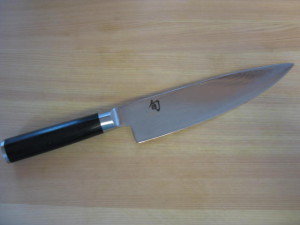 |
| 8″ Chef Knife |
So let’s talk Asian versus German. That’s where the real difference lies. (Real) Asian knives are sharper, and they hold their edge longer because they are folded, not sharpened into an edge. The edge comes naturally so you’re not constantly re-edging it. Shun is the brand I use (Classic line) , and these are made using actual samurai sword manufacturing techniques in Seki City, Japan, where craftsmen have honed this craft for centuries.
However, these knives are more delicate. If you’re someone who likes to throw them in the sink and not wash them right away, these probably aren’t for you. It’s very easy to break a tip if you’re piling other dishes on top of it, etc. Also, they’re really sharp! I decided that my grandma probably couldn’t handle it at her age and opted for a German one as a gift one year, and of course she still loved it.
Most people are more familiar with German knives. Wüstof, Henkels…they’ve been around for years and are found everywhere. These are sturdy, strong knives. Within these brands, they have many different lines and many are outsourced to various other countries, which I know matters to a lot of folks, so make sure you know where the line your looking at was manufactured, don’t just assume they’re made in Germany. It’s the same machines and steel, but they are made in various other countries depending on the line.
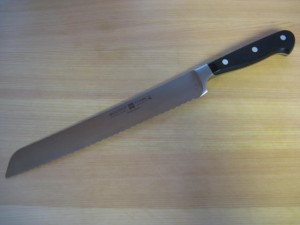 |
| Wüstof Bread Knife (forged) |
A great cheap starter knife is Victorinox/Forschner. These are highly rated knives and most culinary students are using these. Depending on the line, some can be really inexpensive because they have plastic handles, so great as a gift for a new chef!
German knives are also either going to be forged or stamped. Forged means it was probably hand-crafted by someone from a piece of steel, heated, and pounded into shape. This is the more high-quality method, and therefore this will cost more. Stamped means they cookie-cutter stamped a piece of steel, honed, then heat-treated for durability. This will be the cheaper option, but it might not hold up as long.
Another thing to look for in any knife is if it is “full tang”. This means that the metal goes all the way through the handle which should mean a longer lifespan for the knife. If the metal is just attached to the handle, there is a greater chance of it breaking apart from the handle.
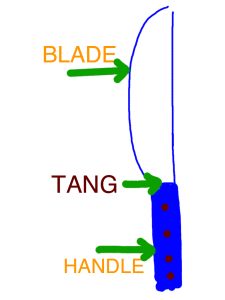 |
| Anatomy of a knife. |
Another option are knives that are guaranteed to stay sharp forever, like Cutco. These knives can cut! The problem is that they DO eventually wear out. It will take a really long time, but when that time comes, you cannot get knives like this re-sharpened because of they way they are made. A great option if you don’t ever want to get your knives sharpened and just want to purchase another set every now and again.
If you are gift shopping, a good indicator is if the person knows what brand they want. If they don’t, just starting out…a German-style knife (most people would just call these “regular” knives, as they are the standard. Asian knives are only in the infancy of their popularity.) is your best bet. Vary the brand/price on who you’re buying for and you should be good. And all brands make Asian style knives these days, at least a Santoku if not anything else (or a mini Santoku! So cute.), so you can always find an inexpensive one for someone who is just starting out but wants to try that style.
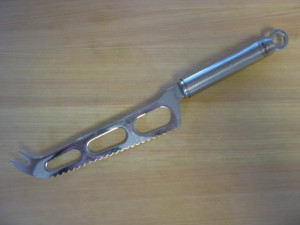 |
|
| Rösle Cheese Knife |
As a side note, there are various types of cheese knives that are generally specific to the type of cheese, or else are for soft, medium, and hard cheeses, respectively. The packaging should indicate the best use. My favorite cheese knife, as I am partial to harder cheese, is this Rösle cheese knife. The holes are to keep cheese from sticking, but if it does stick you can just push the cheese off of the knife from the other side.
